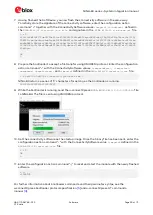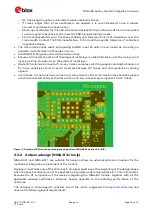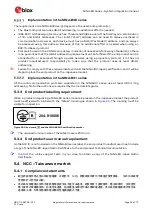
NINA-B3 series - System integration manual
UBX-17056748 - R13
Handling and soldering
Page 44 of 72
C1-Public
4
Handling and soldering
⚠
NINA-B3 series modules are Electrostatic Sensitive Devices that demand the observance of
special handling precautions against electrostatic damage. Failure to observe these precautions
can result in severe damage to the product.
4.1
ESD handling precautions
⚠
As the risk of electrostatic discharge in the RF transceivers and patch antennas of the module is
of particular concern, standard ESD safety practices are prerequisite. See also
Consider also:
•
When connecting test equipment or any other electronics to the module (as a standalone or PCB-
mounted device), the first point of contact must always be to local GND.
•
Before mounting an antenna patch, connect the device to ground.
•
When handling the RF pin, do not touch any charged capacitors. Be especially careful when
handling materials like patch antennas (~10 pF), coaxial cables (~50-80 pF/m), soldering irons, or
any other materials that can develop charges.
•
To prevent electrostatic discharge through the RF input, do not touch any exposed antenna area.
If there is any risk of an exposed antenna being touched in an unprotected ESD work area, be sure
to implement proper ESD protection measures in the design.
•
When soldering RF connectors and patch antennas to the RF pin on the receiver, be sure to use an
ESD-safe soldering iron (tip).
Figure 16: Standard workstation setup for safe handling of ESD-sensitive devices
4.2
Packaging, shipping, storage, and moisture preconditioning
For information pertaining to reels, tapes or trays, moisture sensitivity levels (MSL), shipment and
storage, as well as drying for preconditioning, refer to the respective NINA-B3 data sheet
Packaging information reference guide
4.3
Soldering
☞
No natural rubbers, hygroscopic materials or materials containing asbestos are employed.
















































